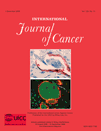Preneoplastic and neoplastic lesions in the lung, liver and urinary tract of mice exposed to environmental cigarette smoke and UV light since birth
Abstract
It is difficult to reproduce the carcinogenicity of cigarette smoke (CS) in animal models. Recently, we showed that exposure of mice to mainstream CS (MCS) for 120 days, starting immediately after birth, resulted in an early and potent carcinogenic response. In parallel, we implemented studies evaluating intermediate biomarkers and tumors in mice exposed to environmental CS (ECS). To this purpose, we used 263 newborn CD-1 mice born from 27 dams. The whole-body exposure to ECS for 120 days, starting within 12 hr after birth, resulted in an early appearance of preneoplastic lesions in lung, which however tended to attenuate after discontinuing exposure. When the experiment was stopped, after 330 days, the number of lung adenomas was higher in ECS-exposed mice as compared to sham-exposed mice, but such increase was statistically significant only in mice co-exposed to smoke and halogen light mimicking solar irradiation. Moreover, exposure to ECS produced extensive histopathological changes, mainly parenchymatous degeneration, in liver. The alterations produced in both lung and liver require that exposure to ECS starts immediately after birth, no effect being observed when exposure started 8 days later. In contrast, induction by ECS of alterations in the urinary tract, such as microadenomas and adenomas in renal pelvis and kidney, papillary hyperplasia of urothelium, and urinary bladder papillomas, were unrelated to the exposure time after birth. The results obtained with ECS cannot be directly compared to those previously obtained with MCS, since the latter involved shorter daily exposures to more massive CS doses. © 2008 Wiley-Liss, Inc.




